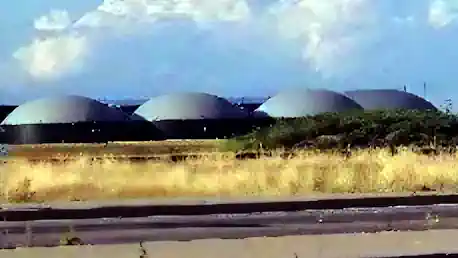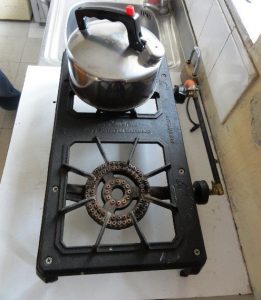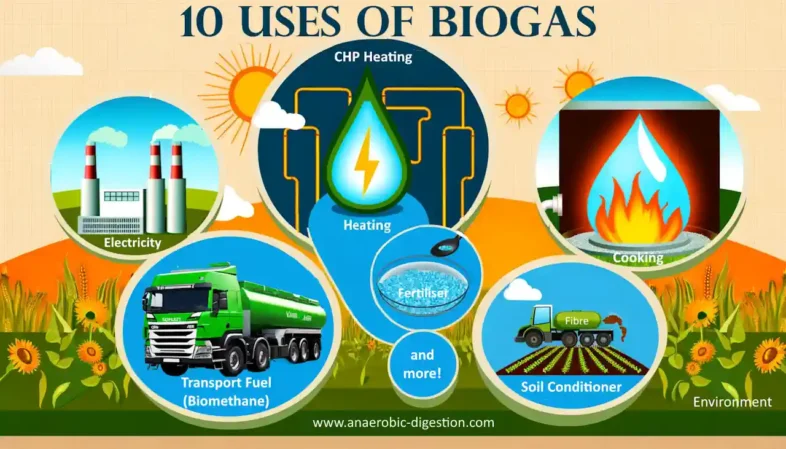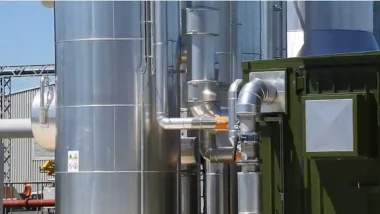We list below 10 uses of biogas in points. These are the ways in which biogas use can be an important technology to help mankind reduce climate change. It's a useful alternative source of renewable energy and, if utilised, would be capable of reducing global warming by about 10%.
Be convinced of the many advantages of biogas use by reading this article.
If you know of even more uses of the green gas from biogas plants, please tell us about it by using the commenting facility below this article.
10 Uses of Biogas from Small and Commercial Scale Biogas Plants
1. Static Direct Combustion Systems

Biogas may be used in direct combustion systems (boilers, turbines, or fuel cells) for providing water heating, space heating, drying, absorption cooling, and steam production on the site of the digester.
This includes the gas used directly in static gas turbines and hydrogen fuel cells to produce electricity. The electricity that is used to power the pump and mixers of the biogas plant itself may also be used to:
- power the farm's electricity needs or the factory or business of the biogas plant owner, or
- export to the local electricity grid and sold to an electricity supply company.
A choice in biogas conversion is its use in stationary internal combustion engines, which results in shaft horsepower, and cogeneration of electricity.
This has much greater potential in the future because the waste products of one cow can provide enough energy to power a standard light bulb for an entire day.
2. Mobile Direct Combustion Systems
If purified (upgraded), concentrated, and compressed, it can be used in vehicle transportation.
Germany, Switzerland, and Sweden are three countries that are rapidly adopting compressed biogas.
There has been a biogas-powered train operating in Sweden since 2005, called Biogaståget Amanda ( Biogas Train Amanda).
You can now purchase biogas-fuel-ready vehicles, from cars up to the largest trucks, and tractors.
3. Producing Biomethane from Biogas

Upgrading biogas to biomethane (also known as RNG) by taking out the carbon dioxide and water, as well as the small amounts of hydrogen sulphide and other traces of impurity, is a sustainable use of biogas.
Methane is also the sole ingredient in conventional natural gas, so biomethane can be used everywhere that natural gas is used, and the market for natural gas is huge.
By upgrading the crude biogas to biomethane that has been cleaned to meet natural gas pipeline quality standards, the biogas producer can sell a premium-value fuel.
Also, the market is huge. This makes it a reliable source of income because the producer is not likely to saturate market demand.
4. The Byproduct of Biogas Known as Digestate Helps Farmers Fertilise Their Crops

It helps in agriculture, as the by-product of biogas helps in the production of organic fertilisers.
Using biogas as a natural fertiliser, instead of spreading manure, helps reduce pollution.
It also makes for a more eco-friendly environment.
It is great for reducing global warming. Plus, it is a cheap and affordable technology.
5. In CHP Gas Engines for District and Housing Estate Heating
When biogas is burned in Gas Engines to generate electricity, the engines themselves get hot and are cooled by circulating water through external cooling jackets. That hot water can be used to heat houses, businesses, and factories.
Hot water from a gas engine cooling jacket can be used for anything requiring hot water, including all sorts of uses in manufacturing processes.
6. Climate Change Minimisation
Biogas plants are being used for climate change minimisation to curb the greenhouse effect.
For example, biogas is purified and injected into the natural gas grid to supply homes and businesses with renewable gas through the natural gas pipeline
Using biogas for this purpose reduces the demand for fossil fuels.
This, in turn, helps cut reliance on the use of fossil fuels, such as oil and coal. And that, in turn, helps nations reduce their carbon emissions (decarbonize).
7. Biogas as A Raw Material to Make Other Chemicals Until Now Made from Oil in Oil Refineries
Methane is the raw material for hydrocarbon production in oil refineries.
Renewable methane can be used instead of methane from fossil fuel sources in refineries. And to make all the different varieties of plastic (hydrocarbon-based) materials now made from oil and natural gas.
For the remainder of our 10 Uses of Biogas, we now look at small-scale anaerobic digestion:
Small Home and Community AD Plant Scale Uses of Biogas
8. Gas Boilers to Produce Heat and Hydrogen
Domestic central heating boilers with hydrogen cells built in are already available. In addition to providing hot water to heat a home, these use a fuel cell which produces electricity while the boiler produces heat, as a normal boiler does as well.
This is a very efficient way to use natural gas. However, using hydrogen fuel cells is even more sustainable when biogas is the source fuel and not natural gas. That's because natural gas comes from fossil fuel sources.
9. Gas Rings, Stoves and Lamps

Biogas can be made at home from waste vegetable matter and used in a similar way to natural gas in gas stoves and lamps.
It removes the need to spend many hours each day walking to the forest and collecting wood fuel.
The time that is released can be used for taking care of children and teaching them life skills.
10. Use in Portable Gen-sets for Off-Grid Living
The last item on our list of biogas uses is as a fuel to power portable electricity-generating sets. Most off-grid homes use portable generator sets, which are internal combustion (IC) engines combined with an alternator or dynamo.
The generator sets (gen-sets) used for running on biogas are the same ones as those used for running on propane gas or natural gas.
They find out the daily power consumption and use that as a guide to their gen-set requirements. The raw biogas should be scrubbed to remove the most corrosive impurities. That needs to be done before it is used in generators, or the useful life of the generator set may be reduced.
Conclusion to Our List of 10 Uses of Biogas
Those are the 10 uses of biogas. Now you know how to use biogas!
However, the choice of the use of biogas needs to be decided upon at the start of an anaerobic digestion plant project. The reason is that the choice of the final means for utilisation of biogas impacts the design.
The end use of your biogas will dictate many decisions about equipment requirements for biogas processing and storage. It will also be fundamental to the economics of operating your biogas conversion system.
FAQs on Uses of Biogas
What is Biogas?
Green waste, food scraps, sewage, plant debris, animal manure, and other organic wastes can be anaerobically digested to create biogas, a sustainable energy source. The main components are carbon dioxide (CO2) and methane (CH4).
How can Biogas be used?
- Electricity Generation: Biogas can be used in a generator to produce electricity.
- Heating: It can provide heating for homes and industrial processes.
- Cooking: Biogas is used as a renewable cooking fuel, particularly in rural areas.
- Transportation Fuel: After purification, biogas can be converted to biomethane, a substitute for natural gas in vehicles.
- As a Natural Fertilizer: The by-product of biogas production, digestate, can be used as a nutrient-rich fertilizer.
What are the benefits of using Biogas?
Using biogas as an energy source offers multiple benefits, including reducing greenhouse gas emissions, managing waste, producing organic fertilizer, and providing a renewable source of energy.
Can Biogas replace natural gas?
It is possible to convert biogas into biomethane, a fuel that may replace natural gas in many places and has many of the same uses, such as in the kitchen, the heating system, and even be a fuel for cars, trucks, trains, and tractors.
Is Biogas production cost-effective?
The cost-effectiveness of biogas production depends on various factors such as feedstock availability, scale of production, and local energy prices. Generally, with the right conditions, biogas can be a cost-effective renewable energy source.
Comparison Table: Biogas vs. Other Renewable Energy Sources
| Energy Source | Advantages | Disadvantages |
|---|---|---|
| Biogas | Reduces waste, produces fertilizer, renewable, always on | Requires continuous supply of organic waste |
| Solar Energy | Abundant, low operating cost, renewable | Intermittent, requires large land area |
| Wind Energy | Renewable, low operating cost, renewable | Intermittent, noise and visual impact |
How does biogas production impact the environment?
Biogas production positively impacts the environment by reducing methane emissions from organic waste, decreasing reliance on fossil fuels, and producing organic fertilizer that can reduce the need for chemical fertilizers.
[First published 5 November 2019. Updated: February 2024.]






Hi there! HAd no idea there were so many ways we could use biogas. Someone in my Facebook group shared this website with us so I came to give it a look. Excellent blog.